refuelling Peugeot 508 RXH 2013 Owner's Manual
[x] Cancel search | Manufacturer: PEUGEOT, Model Year: 2013, Model line: 508 RXH, Model: Peugeot 508 RXH 2013Pages: 308, PDF Size: 8.95 MB
Page 37 of 308
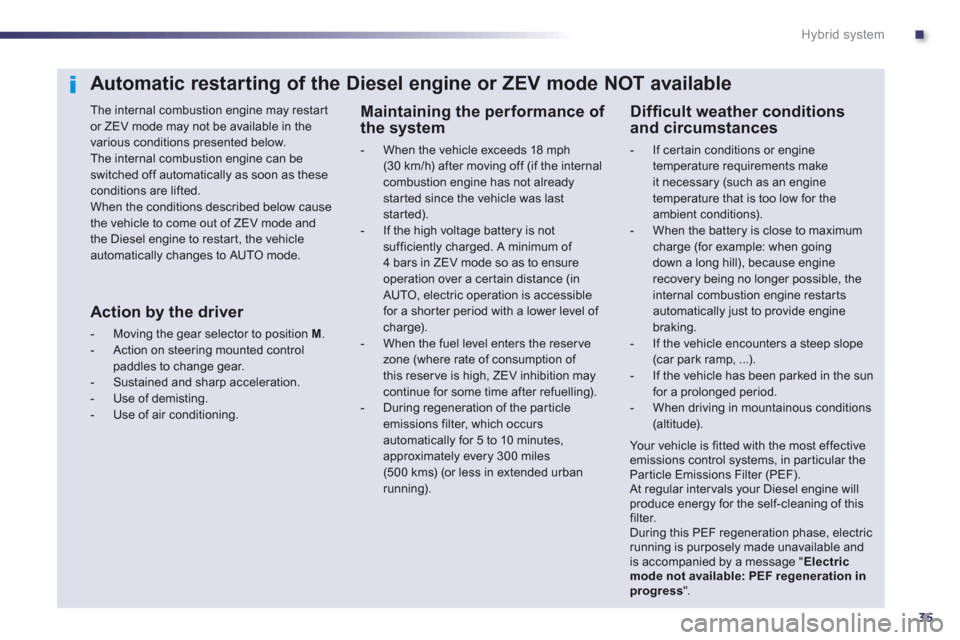
.
35
Hybrid system
Automatic restarting of the Diesel engine or ZEV mode NOT available
The internal combustion engine may restar t or ZEV mode may not be available in the various conditions presented below.
The internal combustion engine can be switched off automatically as soon as these conditions are lifted. When the conditions described below causethe vehicle to come out of ZEV mode and the Diesel engine to restar t, the vehicleautomatically changes to AUTO mode.
Diffi cult weather conditions and circumstances
- If certain conditions or engine
temperature requirements make it necessary (such as an enginetemperature that is too low for the ambient conditions). - When the battery is close to maximum charge (for example: when goingdown a long hill), because enginerecovery being no longer possible, theinternal combustion engine restarts automatically just to provide engine braking.- If the vehicle encounters a steep slope (car park ramp, ...).- If the vehicle has been parked in the sun for a prolonged period.- When driving in mountainous conditions (altitude).
Your vehicle is fitted with the most effectiveemissions control systems, in par ticular theParticle Emissions Filter (PEF). At regular intervals your Diesel engine will produce energy for the self-cleaning of this filter.During this PEF regeneration phase, electric running is purposely made unavailable andis accompanied by a message "Electricmode not available: PEF regeneration inprogress
".
Maintaining the performance of the system
- When the vehicle exceeds 18 mph
(30 km/h) after moving off (if the internal combustion engine has not alreadystarted since the vehicle was last started). - If the high voltage battery is notsufficiently charged. A minimum of 4 bars in ZEV mode so as to ensure operation over a cer tain distance (in AUTO, electric operation is accessiblefor a shorter period with a lower level of charge).- When the fuel level enters the reserve zone (where rate of consumption of this reserve is high, ZEV inhibition maycontinue for some time after refuelling).- During regeneration of the par ticle emissions filter, which occurs
automatically for 5 to 10 minutes, approximately every 300 miles(500 kms) (or less in extended urban running).
Action by the driver
- Moving the gear selector to position M.
- Action on steering mounted controlpaddles to change gear.
- Sustained and sharp acceleration.
- Use of demisting.
- Use of air conditioning.
Page 43 of 308
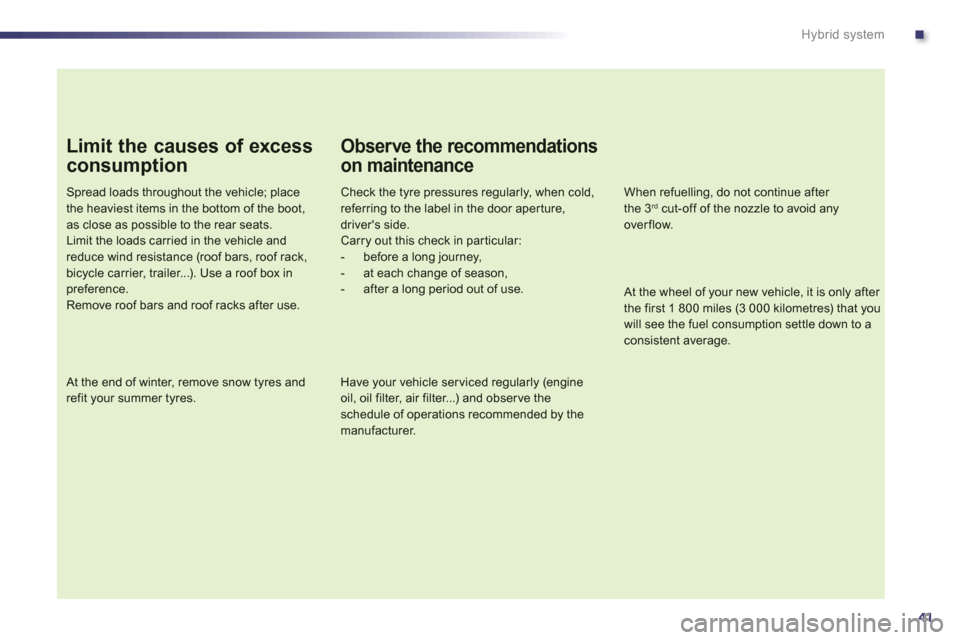
.
41
Hybrid system
Limit the causes of excess
consumption
Spread loads throughout the vehicle; placethe heaviest items in the bottom of the boot,
as close as possible to the rear seats.Limit the loads carried in the vehicle and reduce wind resistance (roof bars, roof rack, bicycle carrier, trailer...). Use a roof box inpreference.Remove roof bars and roof racks after use.
At the end of winter, remove snow tyres and refit your summer tyres.
Observe the recommendations
on maintenance
Check the tyre pressures regularly, when cold, referring to the label in the door aper ture, driver's side.Carry out this check in par ticular:- before a long journey,- at each change of season,- after a long period out of use.
When refuelling, do not continue after the 3rdcut-off of the nozzle to avoid any overflow.
Have your vehicle ser viced regularly (engine oil, oil filter, air filter...) and obser ve the schedule of operations recommended by the
manufacturer.
At the wheel of your new vehicle, it is only after the first 1 800 miles (3 000 kilometres) that youwill see the fuel consumption settle down to aconsistent average.
Page 48 of 308
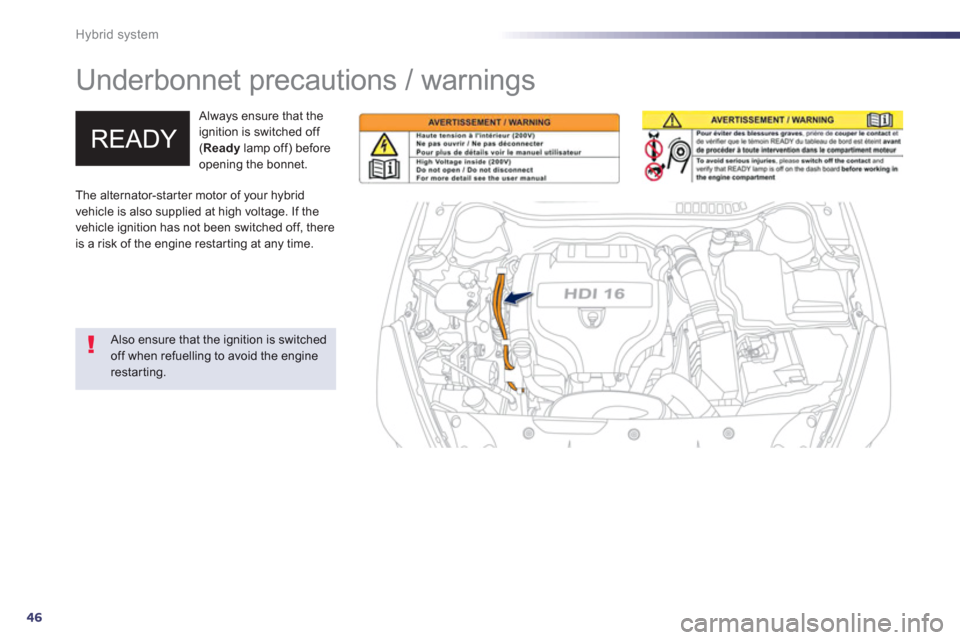
46
Hybrid system
Underbonnet precautions / warnings
Always ensure that the
ignition is switched off (Readylamp off) before
opening the bonnet.
Also ensure that the ignition is switched off when refuelling to avoid the engine restarting. The alternator-star ter motor o
f your hybrid
vehicle is also supplied at high voltage. If the
vehicle ignition has not been switched off, there
is a risk of the engine restar ting at any time.
Page 91 of 308
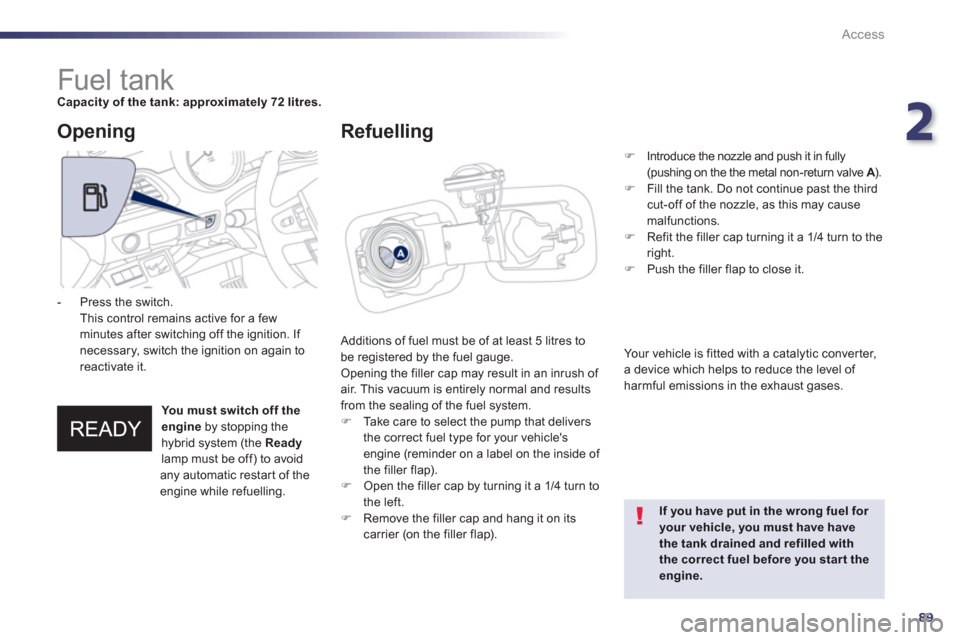
2
89
Access
Fuel tank Capacity of the tank: approximately 72 litres.
Additions of fuel must be of at least 5 litres to
be registered by the fuel gauge.Opening the filler cap may result in an inrush of air. This vacuum is entirely normal and results from the sealing of the fuel system.�) Take care to select the pump that delivers
the correct fuel t
ype for your vehicle'sengine (reminder on a label on the inside of
the filler flap).�) Open the filler cap by turning it a 1/4 turn to
the left. �) Remove the filler cap and hang it on its carrier (on the filler flap).
Opening
If you have put in the wrong fuel for your vehicle, you must have havethe tank drained and refilled with the correct fuel before you start theengine.
- Press the switch.
This control remains active for a fewminutes after switching off the ignition. If necessary, switch the ignition on again toreactivate it.
Refuelling
�)
Introduce the nozzle and push it in fully(pushing on the the metal non-return valve A
). AA�)
Fill the tank. Do not continue past the thirdcut-off of the nozzle, as this may cause malfunctions. �)
Refit the filler cap turning it a 1/4 turn to the
right. �) Push the filler flap to close it.
Your vehicle is
fitted with a catalytic converter,
a device which helps to reduce the level of
harmful emissions in the exhaust gases.
You must switch off theengine by stopping the
hybrid system (the Readylamp must be off) to avoid any automatic restar t of the
engine while refuelling.
Page 92 of 308
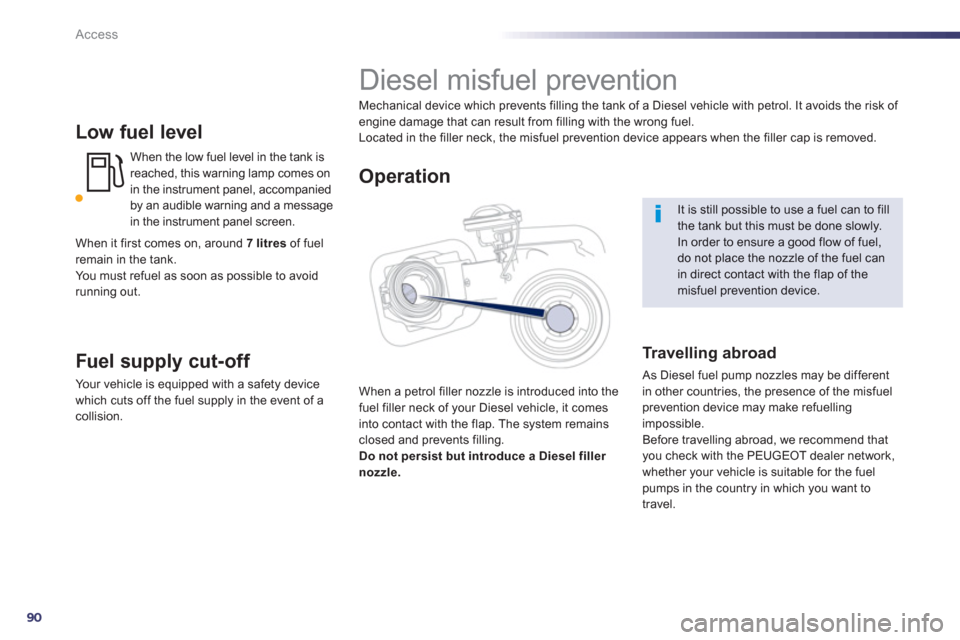
90
Access
Low fuel level
When the low fuel level in the tank isreached, this warning lamp comes on in the instrument panel, accompanied by an audible warning and a message
in the instrument panel screen.
Fuel supply cut-off
Your vehicle is equipped with a safety device
which cuts off the fuel supply in the event of a collision.
It is still possible to use a fuel can to fill
the tank but this must be done slowly. In order to ensure a good flow of fuel, do not place the nozzle of the fuel canin direct contact with the flap of themisfuel prevention device.
Diesel misfuel prevention
Mechanical device which prevents filling the tank of a Diesel vehicle with petrol. It avoids the risk of engine damage that can result from filling with the wrong fuel.
Located in the filler neck, the misfuel prevention device appears when the filler cap is removed.
When a petrol
filler nozzle is introduced into the fuel filler neck of your Diesel vehicle, it comes
into contact with the flap. The system remains
closed and prevents filling. Do not persist but introduce a Diesel filler
nozzle.
Operation
Tr a v e l l i ng abroad
As Diesel fuel pump nozzles may be different
in other countries, the presence of the misfuel prevention device may make refuellingimpossible.
Before travelling abroad, we recommend that you check with the PEUGEOT dealer network,
whether your vehicle is suitable for the fuelpumps in the country in which you want to
travel.
When it
first comes on, around 7 litresof fuelremain in the tank.
You must refuel as soon as possible to avoid
running out.
Page 124 of 308
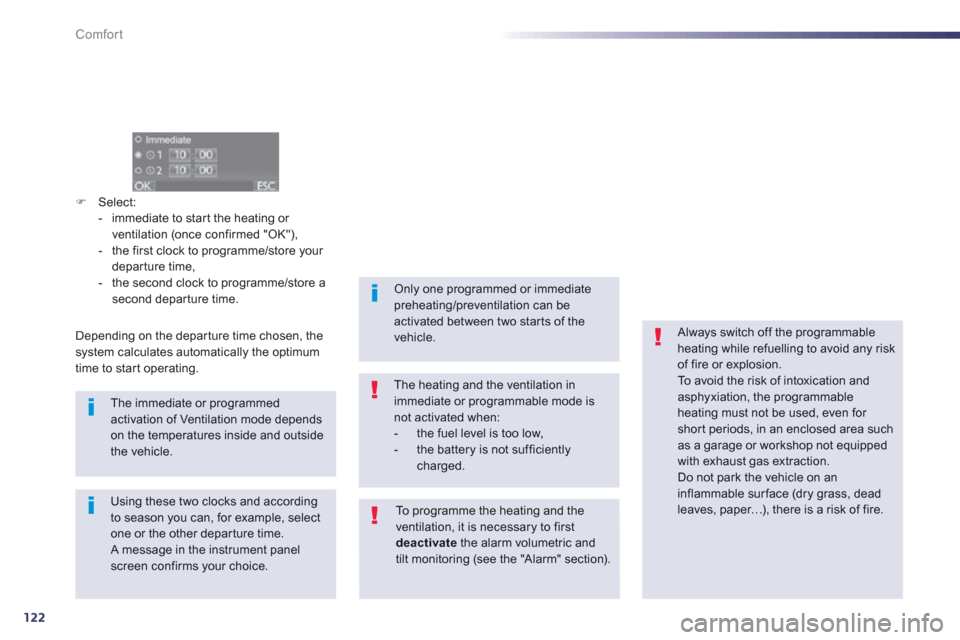
122
Comfort
�)Select:
- immediate to star t the heating or
ventilation
(once confirmed "OK"),
- the first clock to programme/store your departure time,
- the second clock to programme/store a
second depar ture time.
The immediate or programmedactivation of Ventilation mode depends on the temperatures inside and outsidethe vehicle.
Depending on the departure time chosen, the system calculates automatically the optimum
time to star t operating.
Using these two clocks and according to season you can, for example, select one or the other depar ture time. A message in the instrument panel screen confirms your choice.
Only one programmed or immediatepreheating/preventilation can beactivated between two starts of thevehicle.
The heating and the ventilation inimmediate or programmable mode isnot activated when: - the fuel level is too low,- the battery is not sufficientlycharged.
To p r ogramme the heating and theventilation, it is necessary to firstdeactivate
the alarm volumetric and tilt monitoring (see the "Alarm" section).
Always switch off the programmableheating while refuelling to avoid any riskof fire or explosion.
To avoid the risk of intoxication andasphyxiation, the programmable heating must not be used, even for short periods, in an enclosed area such as a garage or workshop not equipped with exhaust gas extraction.
Do not park the vehicle on an inflammable sur face (dry grass, dead leaves, paper…), there is a risk of fire.